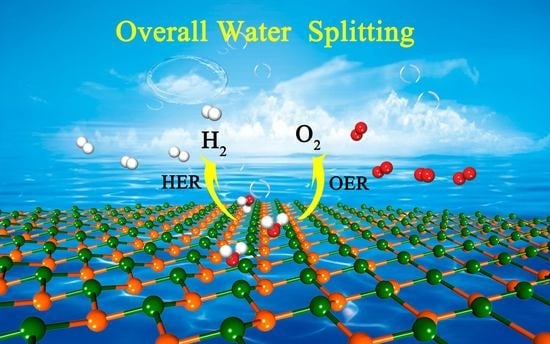Theoretical Study on the High HER/OER Electrocatalytic Activities of 2D GeSi, SnSi, and SnGe Monolayers and Further Improvement by Imposing Biaxial Strain or Doping Heteroatoms
Abstract
:1. Introduction
2. Results and Discussion
2.1. The Geometries, Stabilities, and Electronic Properties of 2D GeSi, SnSi, and SnGe Monolayers
2.2. The HER/OER Catalytic Activities of 2D Pristine GeSi, SnSi, and SnGe Monolayers
2.3. Two Effective Strategies to Improve HER Catalytic Activities of 2D Pristine GeSi, SnSi, and SnGe Monolayers
2.3.1. Applying Biaxial Strain to Boost the HER Catalytic Activities of GeSi, SnSi, and SnGe Systems
2.3.2. Doping Heteroatoms to Enhance the HER Activities of GeSi, SnSi, and SnGe Systems
3. Computational Methods
4. Conclusions
Supplementary Materials
Author Contributions
Funding
Institutional Review Board Statement
Informed Consent Statement
Data Availability Statement
Acknowledgments
Conflicts of Interest
Sample Availability
References
- Chu, S.; Majumdar, A. Opportunities and challenges for a sustainable energy future. Nature 2012, 488, 294–303. [Google Scholar] [CrossRef] [PubMed]
- Cano, Z.P.; Banham, D.; Ye, S.; Hintennach, A.; Lu, J.; Fowler, M.; Chen, Z. Batteries and fuel cells for emerging electric vehicle markets. Nat. Energy 2018, 3, 279–289. [Google Scholar] [CrossRef]
- Yu, Y.; Zhou, J.; Sun, Z. Novel 2D Transition-Metal Carbides: Ultrahigh Performance Electrocatalysts for Overall Water Splitting and Oxygen Reduction. Adv. Funct. Mater. 2020, 30, 2000570. [Google Scholar] [CrossRef]
- Jiao, Y.; Zheng, Y.; Jaroniec, M.; Qiao, S.Z. Design of electrocatalysts for oxygen-and hydrogen-involving energy conversion reactions. Chem. Soc. Rev. 2015, 44, 2060–2086. [Google Scholar] [CrossRef]
- Wang, J.; Kong, H.; Zhang, J.; Hao, Y.; Shao, Z.; Ciucci, F. Carbon-based electrocatalysts for sustainable energy applications. Prog. Mater. Sci. 2021, 116, 100717. [Google Scholar] [CrossRef]
- Subbaraman, R.; Tripkovic, D.; Strmcnik, D.; Chang, K.-C.; Uchimura, M.; Paulikas, A.P.; Stamenkovic, V.; Markovic, N.M. Enhancing hydrogen evolution activity in water splitting by tailoring Li+-Ni (OH) 2-Pt interfaces. Science 2011, 334, 1256–1260. [Google Scholar] [CrossRef]
- Debe, M.K. Electrocatalyst approaches and challenges for automotive fuel cells. Nature 2012, 486, 43–51. [Google Scholar] [CrossRef]
- Xu, H.; Cheng, D.; Cao, D.; Zeng, X.C. A universal principle for a rational design of single-atom electrocatalysts. Nat. Catal. 2018, 1, 339–348. [Google Scholar] [CrossRef]
- Ku, R.; Yu, G.; Gao, J.; Huang, X.; Chen, W. Embedding tetrahedral 3d transition metal TM 4 clusters into the cavity of two-dimensional graphdiyne to construct highly efficient and nonprecious electrocatalysts for hydrogen evolution reaction. Phys. Chem. Chem. Phys. 2020, 22, 3254–3263. [Google Scholar] [CrossRef]
- Liu, J.; Yu, G.; Huang, X.; Chen, W. The crucial role of strained ring in enhancing the hydrogen evolution catalytic activity for the 2D carbon allotropes: A high-throughput first-principles investigation. 2D Mater. 2019, 7, 015015. [Google Scholar] [CrossRef]
- Zhang, K.; Zou, R. Advanced Transition Metal-Based OER Electrocatalysts: Current Status, Opportunities, and Challenges. Small 2021, 17, 2100129. [Google Scholar] [CrossRef]
- Wang, M.; Zhu, H. Machine learning for transition-metal-based hydrogen generation electrocatalysts. ACS Catal. 2021, 11, 3930–3937. [Google Scholar] [CrossRef]
- Du, J.; Li, F.; Sun, L. Metal–organic frameworks and their derivatives as electrocatalysts for the oxygen evolution reaction. Chem. Soc. Rev. 2021, 50, 2663–2695. [Google Scholar] [CrossRef]
- Huang, W.; Tang, J.; Diao, F.; Engelbrekt, C.; Ulstrup, J.; Xiao, X.; Mølhave, K. Recent Progress of Two-Dimensional Metal-Organic Frameworks and Their Derivatives for Oxygen Evolution Electrocatalysis. ChemElectroChem 2020, 7, 4695–4712. [Google Scholar] [CrossRef]
- Wang, H.; Lee, H.-W.; Deng, Y.; Lu, Z.; Hsu, P.-C.; Liu, Y.; Lin, D.; Cui, Y. Bifunctional non-noble metal oxide nanoparticle electrocatalysts through lithium-induced conversion for overall water splitting. Nat. Commun. 2015, 6, 7261. [Google Scholar] [CrossRef] [Green Version]
- Zhang, T.; Zhang, B.; Peng, Q.; Zhou, J.; Sun, Z. Mo2B2 MBene-supported single-atom catalysts as bifunctional HER/OER and OER/ORR electrocatalysts. J. Mater. Chem. A 2021, 9, 433–441. [Google Scholar] [CrossRef]
- Wang, J.; Fan, Y.; Qi, S.; Li, W.; Zhao, M. Bifunctional HER/OER or OER/ORR catalytic activity of two-dimensional TM3 (HITP) 2 with TM= Fe–Zn. J. Phys. Chem. C 2020, 124, 9350–9359. [Google Scholar] [CrossRef]
- Wu, H.; Wang, J.; Jin, W.; Wu, Z. Recent development of two-dimensional metal–organic framework derived electrocatalysts for hydrogen and oxygen electrocatalysis. Nanoscale 2020, 12, 18497–18522. [Google Scholar] [CrossRef]
- Wang, J.; Wang, J.; Song, X.; Qi, S.; Zhao, M. Multifunctional electrocatalytic activity of coronene-based two-dimensional metal-organic frameworks: TM-PTC. Appl. Surf. Sci. 2020, 511, 145393. [Google Scholar] [CrossRef]
- Wang, J.; Wang, J.; Qi, S.; Zhao, M. Stable multifunctional single-atom catalysts resulting from the synergistic effect of anchored transition-metal atoms and host covalent–organic frameworks. J. Phys. Chem. C 2020, 124, 17675–17683. [Google Scholar] [CrossRef]
- Novoselov, K.S.; Geim, A.K.; Morozov, S.V.; Jiang, D.-e.; Zhang, Y.; Dubonos, S.V.; Grigorieva, I.V.; Firsov, A.A. Electric field effect in atomically thin carbon films. Science 2004, 306, 666–669. [Google Scholar] [CrossRef] [Green Version]
- Kundu, S.; Nagaiah, T.C.; Xia, W.; Wang, Y.; Dommele, S.V.; Bitter, J.H.; Santa, M.; Grundmeier, G.; Bron, M.; Schuhmann, W. Electrocatalytic activity and stability of nitrogen-containing carbon nanotubes in the oxygen reduction reaction. J. Phys. Chem. C 2009, 113, 14302–14310. [Google Scholar] [CrossRef]
- Sun, Y.; Wu, Q.; Shi, G. Graphene based new energy materials. Energy Environ. Sci. 2011, 4, 1113–1132. [Google Scholar] [CrossRef]
- Sathe, B.R.; Zou, X.; Asefa, T. Metal-free B-doped graphene with efficient electrocatalytic activity for hydrogen evolution reaction. Catal. Sci. Technol. 2014, 4, 2023–2030. [Google Scholar] [CrossRef]
- He, T.; Matta, S.K.; Du, A. Single tungsten atom supported on N-doped graphyne as a high-performance electrocatalyst for nitrogen fixation under ambient conditions. Phys. Chem. Chem. Phys. 2019, 21, 1546–1551. [Google Scholar] [CrossRef]
- Kong, X.; Liu, Q.; Chen, D.; Chen, G. Identifying the Active Sites on N-doped Graphene toward Oxygen Evolution Reaction. ChemCatChem 2017, 9, 846–852. [Google Scholar] [CrossRef]
- Xiao, Z.; Huang, X.; Xu, L.; Yan, D.; Huo, J.; Wang, S. Edge-selectively phosphorus-doped few-layer graphene as an efficient metal-free electrocatalyst for the oxygen evolution reaction. Chem. Commun. 2016, 52, 13008–13011. [Google Scholar] [CrossRef] [PubMed]
- Pan, Y.; Zhang, C.; Liu, Z.; Chen, C.; Li, Y. Structural regulation with atomic-level precision: From single-atomic site to diatomic and atomic interface catalysis. Matter 2020, 2, 78–110. [Google Scholar] [CrossRef]
- Wang, B.; Liu, B.; Dai, L. Non-N-Doped Carbons as Metal-Free Electrocatalysts. Adv. Sust. Syst. 2021, 5, 2000134. [Google Scholar] [CrossRef]
- Suryawanshi, U.P.; Ghorpade, U.V.; Lee, D.M.; He, M.; Shin, S.W.; Kumar, P.V.; Jang, J.S.; Jung, H.R.; Suryawanshi, M.P.; Kim, J.H. Colloidal Ni2P nanocrystals encapsulated in heteroatom-doped graphene nanosheets: A synergy of 0D@ 2D heterostructure toward overall water splitting. Chem. Mater. 2020, 33, 234–245. [Google Scholar] [CrossRef]
- Zhang, L.; Jia, Y.; Gao, G.; Yan, X.; Chen, N.; Chen, J.; Soo, M.T.; Wood, B.; Yang, D.; Du, A. Graphene defects trap atomic Ni species for hydrogen and oxygen evolution reactions. Chem 2018, 4, 285–297. [Google Scholar] [CrossRef] [Green Version]
- Shi, J.; Gao, Y.; Wang, X.-L.; Yun, S.-N. Electronic, elastic and piezoelectric properties of two-dimensional group-IV buckled monolayers. Chin. Phys. Lett. 2017, 34, 087701. [Google Scholar] [CrossRef]
- Şahin, H.; Cahangirov, S.; Topsakal, M.; Bekaroglu, E.; Akturk, E.; Senger, R.T.; Ciraci, S. Monolayer honeycomb structures of group-IV elements and III-V binary compounds: First-principles calculations. Phys. Rev. B 2009, 80, 155453. [Google Scholar] [CrossRef] [Green Version]
- Sosa, A.N.; Cid, B.J.; Miranda, Á.; Pérez, L.A.; Salazar, F.; Trejo, A.; Cruz-Irisson, M. Light metal functionalized two-dimensional siligene for high capacity hydrogen storage: DFT study. Int. J. Hydrogen Energy 2021, 46, 29348–29360. [Google Scholar] [CrossRef]
- Zhu, P.; Zu, Y.; Kuai, Y.; Gao, S.; Wu, G.; Chen, W.; Wu, L.; Chen, C.; Liu, G. Novel high-performance anodic materials for lithium ion batteries: Two-dimensional Sn–X (X= C, Si, and Ge) alloy monolayers. Phys. Chem. Chem. Phys. 2021, 23, 26428–26437. [Google Scholar] [CrossRef]
- Fadaie, M.; Shahtahmassebi, N.; Roknabad, M.; Gulseren, O. Investigation of new two-dimensional materials derived from stanene. Comp. Mater. Sci. 2017, 137, 208–214. [Google Scholar] [CrossRef] [Green Version]
- Martyna, G.J.; Klein, M.L.; Tuckerman, M. Nosé–Hoover chains: The canonical ensemble via continuous dynamics. J. Chem. Phys. 1992, 97, 2635–2643. [Google Scholar] [CrossRef]
- Chen, Y.; Sun, Q.; Jena, P. SiTe monolayers: Si-based analogues of phosphorene. J. Mater. Chem. C 2016, 4, 6353–6361. [Google Scholar] [CrossRef]
- Silvi, B.; Savin, A. Classification of chemical bonds based on topological analysis of electron localization functions. Nature 1994, 371, 683–686. [Google Scholar] [CrossRef]
- Kibsgaard, J.; Tsai, C.; Chan, K.; Benck, J.D.; Nørskov, J.K.; Abild-Pedersen, F.; Jaramillo, T.F. Designing an improved transition metal phosphide catalyst for hydrogen evolution using experimental and theoretical trends. Energy Environ. Sci. 2015, 8, 3022–3029. [Google Scholar] [CrossRef]
- Wang, J.; Liu, J.; Zhang, B.; Ji, X.; Xu, K.; Chen, C.; Miao, L.; Jiang, J. The mechanism of hydrogen adsorption on transition metal dichalcogenides as hydrogen evolution reaction catalyst. Phys. Chem. Chem. Phys. 2017, 19, 10125–10132. [Google Scholar] [CrossRef]
- Li, C.; Yu, G.; Li, Y.; Chen, W. Increasing Silicon Concentration and Doping Heteroatom to Successfully Realize High HER Catalytic Activity in 2D Metal-Free BSi n (n= 1–4) Structures: A First-Principles Study. J. Electrochem. Soc. 2021, 168, 126527. [Google Scholar] [CrossRef]
- Zhang, J.; Liu, Y.; Sun, C.; Xi, P.; Peng, S.; Gao, D.; Xue, D. Accelerated hydrogen evolution reaction in CoS2 by transition-metal doping. ACS Energy Lett. 2018, 3, 779–786. [Google Scholar] [CrossRef]
- Yao, S.; Zhang, X.; Chen, A.; Zhang, Z.; Jiao, M.; Zhou, Z. Algorithm screening to accelerate discovery of 2D metal-free electrocatalysts for hydrogen evolution reaction. J. Mater. Chem. A 2019, 7, 19290–19296. [Google Scholar] [CrossRef]
- Liu, F.; He, W.; Li, Y.; Wang, F.; Zhang, J.; Xu, X.; Xue, Y.; Tang, C.; Liu, H.; Zhang, J. Activating sulfur sites of CoS2 electrocatalysts through tin doping for hydrogen evolution reaction. Appl. Surf. Sci. 2021, 546, 149101. [Google Scholar] [CrossRef]
- Xiao, B.; Huang, Q.; Wu, J.; Song, E.; Jiang, Q. Tetragonal transition metal selenide for hydrogen evolution. Appl. Surf. Sci. 2022, 591, 153249. [Google Scholar] [CrossRef]
- Meng, Z.; Zhang, B.; Peng, Q.; Yu, Y.; Zhou, J.; Sun, Z. MXenes modified by single transition metal atom for hydrogen evolution reaction catalysts. Appl. Surf. Sci. 2021, 562, 150151. [Google Scholar] [CrossRef]
- Yang, X.; Feng, Z.; Guo, Z. Theoretical Investigation on the Hydrogen Evolution, Oxygen Evolution, and Oxygen Reduction Reactions Performances of Two-Dimensional Metal-Organic Frameworks Fe3(C2X)12 (X = NH, O, S). Molecules 2022, 27, 1528. [Google Scholar] [CrossRef]
- Man, I.C.; Su, H.Y.; Calle-Vallejo, F.; Hansen, H.A.; Martínez, J.I.; Inoglu, N.G.; Kitchin, J.; Jaramillo, T.F.; Nørskov, J.K.; Rossmeisl, J. Universality in oxygen evolution electrocatalysis on oxide surfaces. ChemCatChem 2011, 3, 1159–1165. [Google Scholar] [CrossRef]
- Ishaq, M.W.; Nawaz, R.; Jalil, A.; Hashmi, M.A.; Zheng, T.; Li, L. Ligand Exchange Reaction in [Co4O4]-Cobalt Cubane: A Versatile Strategy Towards the Preparation of Cobalt Cubane-based Functional Small Molecules and Polymeric Materials. J. Mol. Struct. 2021, 1235, 130216. [Google Scholar] [CrossRef]
- Khan, Q.U.; Ishaq, M.W.; Begum, N.; Khan, K.; Khan, U.; Khan, A.T.; Din, M.A.U.; Idrees, M.; Zhu, L. Nanoscale CuTe electrocatalyst immobilized at conductor surface for remarkable hydrogen evolution reaction. Int. J. Hydrogen Energy 2021, 46, 18729–18739. [Google Scholar] [CrossRef]
- Perdew, J.P.; Burke, K.; Ernzerhof, M. Generalized Gradient Approximation Made Simple. Phys. Rev. Lett. 1996, 77, 3865–3868. [Google Scholar] [CrossRef] [PubMed] [Green Version]
- Kresse, G.; Hafner, J. Ab initio molecular-dynamics simulation of the liquid-metal–amorphous-semiconductor transition in germanium. Phys. Rev. B 1994, 49, 14251. [Google Scholar] [CrossRef] [PubMed]
- Kresse, G.; Furthmüller, J. Efficient iterative schemes for ab initio total-energy calculations using a plane-wave basis set. Phys. Rev. B Condens. Matter Mater. Phys. 1996, 54, 11169. [Google Scholar] [CrossRef]
- Grimme, S. Semiempirical GGA-type density functional constructed with a long-range dispersion correction. J. Comput. Chem. 2006, 27, 1787–1799. [Google Scholar] [CrossRef]
- Wu, X.; Vargas, M.; Nayak, S.; Lotrich, V.; Scoles, G. Towards extending the applicability of density functional theory to weakly bound systems. J. Chem. Phys. 2001, 115, 8748–8757. [Google Scholar] [CrossRef]
- Hansen, H.A.; Rossmeisl, J.; Nørskov, J.K. Surface Pourbaix diagrams and oxygen reduction activity of Pt, Ag and Ni (111) surfaces studied by DFT. Phys. Chem. Chem. Phys. 2008, 10, 3722–3730. [Google Scholar] [CrossRef]
- Valdés, Á.; Qu, Z.-W.; Kroes, G.-J.; Rossmeisl, J.; Nørskov, J.K. Oxidation and photo-oxidation of water on TiO2 surface. J. Phys. Chem. C 2008, 112, 9872–9879. [Google Scholar] [CrossRef]
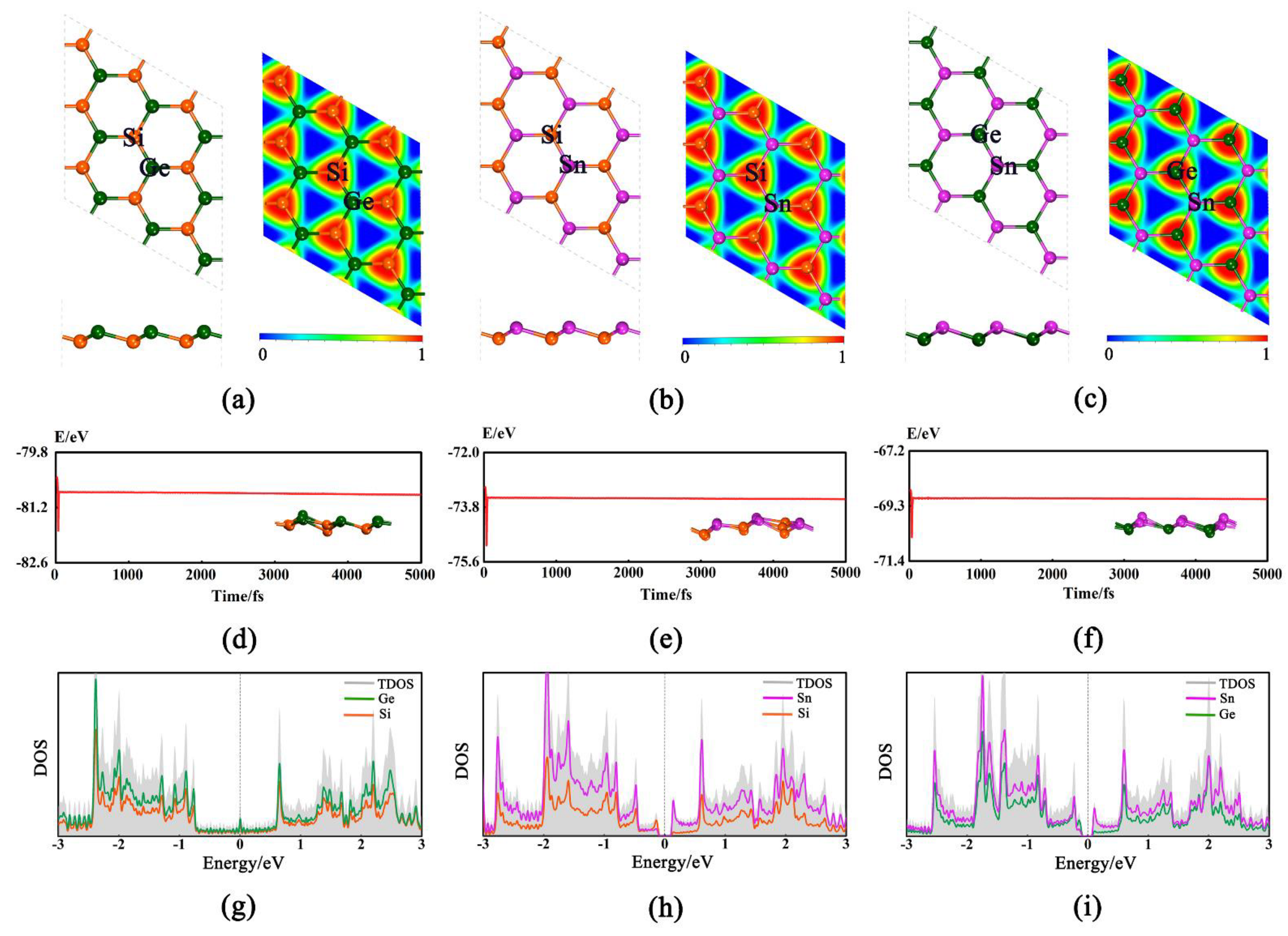
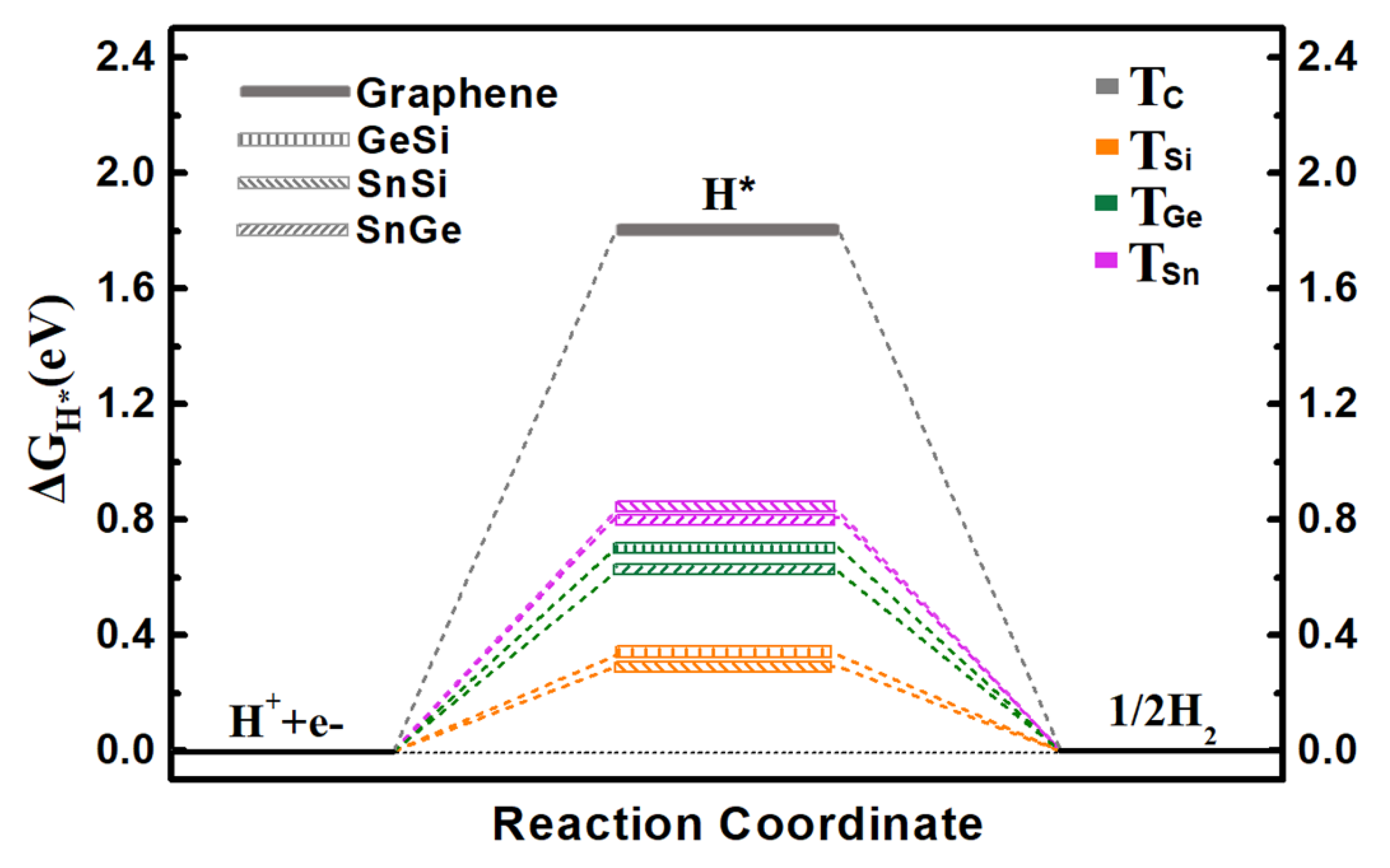
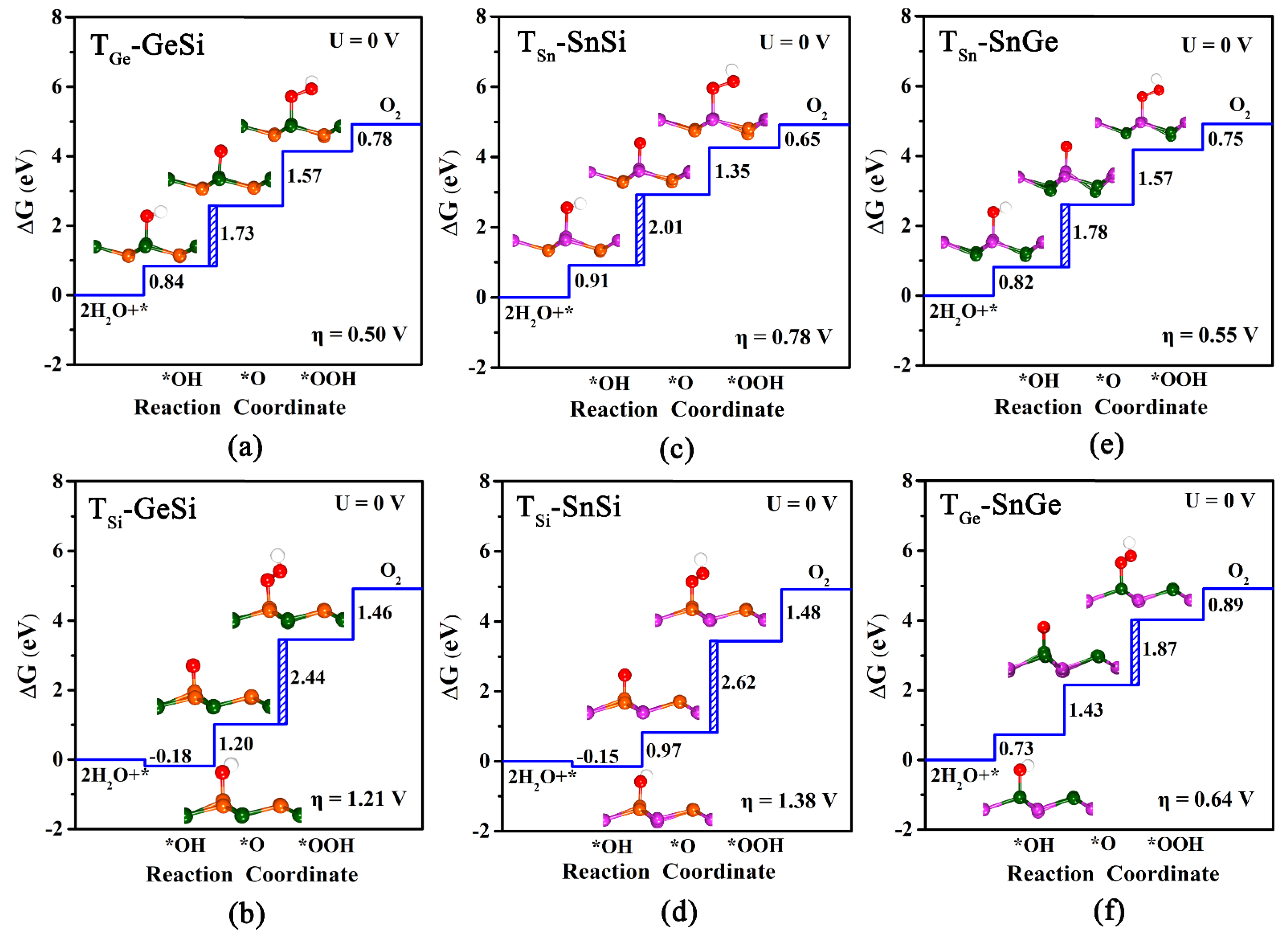
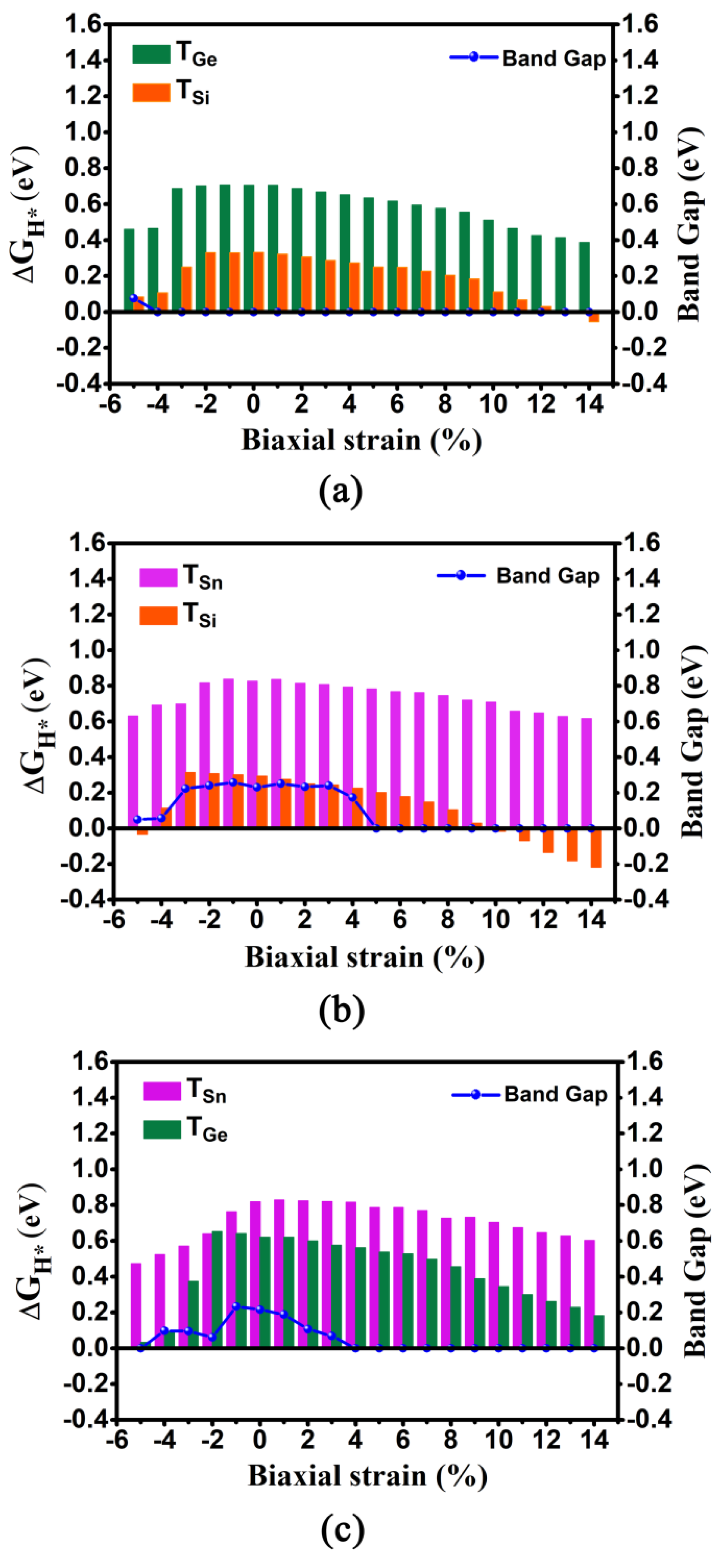


Publisher’s Note: MDPI stays neutral with regard to jurisdictional claims in published maps and institutional affiliations. |
© 2022 by the authors. Licensee MDPI, Basel, Switzerland. This article is an open access article distributed under the terms and conditions of the Creative Commons Attribution (CC BY) license (https://creativecommons.org/licenses/by/4.0/).
Share and Cite
Li, C.; Yu, G.; Shen, X.; Li, Y.; Chen, W. Theoretical Study on the High HER/OER Electrocatalytic Activities of 2D GeSi, SnSi, and SnGe Monolayers and Further Improvement by Imposing Biaxial Strain or Doping Heteroatoms. Molecules 2022, 27, 5092. https://doi.org/10.3390/molecules27165092
Li C, Yu G, Shen X, Li Y, Chen W. Theoretical Study on the High HER/OER Electrocatalytic Activities of 2D GeSi, SnSi, and SnGe Monolayers and Further Improvement by Imposing Biaxial Strain or Doping Heteroatoms. Molecules. 2022; 27(16):5092. https://doi.org/10.3390/molecules27165092
Chicago/Turabian StyleLi, Cuimei, Guangtao Yu, Xiaopeng Shen, Ying Li, and Wei Chen. 2022. "Theoretical Study on the High HER/OER Electrocatalytic Activities of 2D GeSi, SnSi, and SnGe Monolayers and Further Improvement by Imposing Biaxial Strain or Doping Heteroatoms" Molecules 27, no. 16: 5092. https://doi.org/10.3390/molecules27165092
APA StyleLi, C., Yu, G., Shen, X., Li, Y., & Chen, W. (2022). Theoretical Study on the High HER/OER Electrocatalytic Activities of 2D GeSi, SnSi, and SnGe Monolayers and Further Improvement by Imposing Biaxial Strain or Doping Heteroatoms. Molecules, 27(16), 5092. https://doi.org/10.3390/molecules27165092





